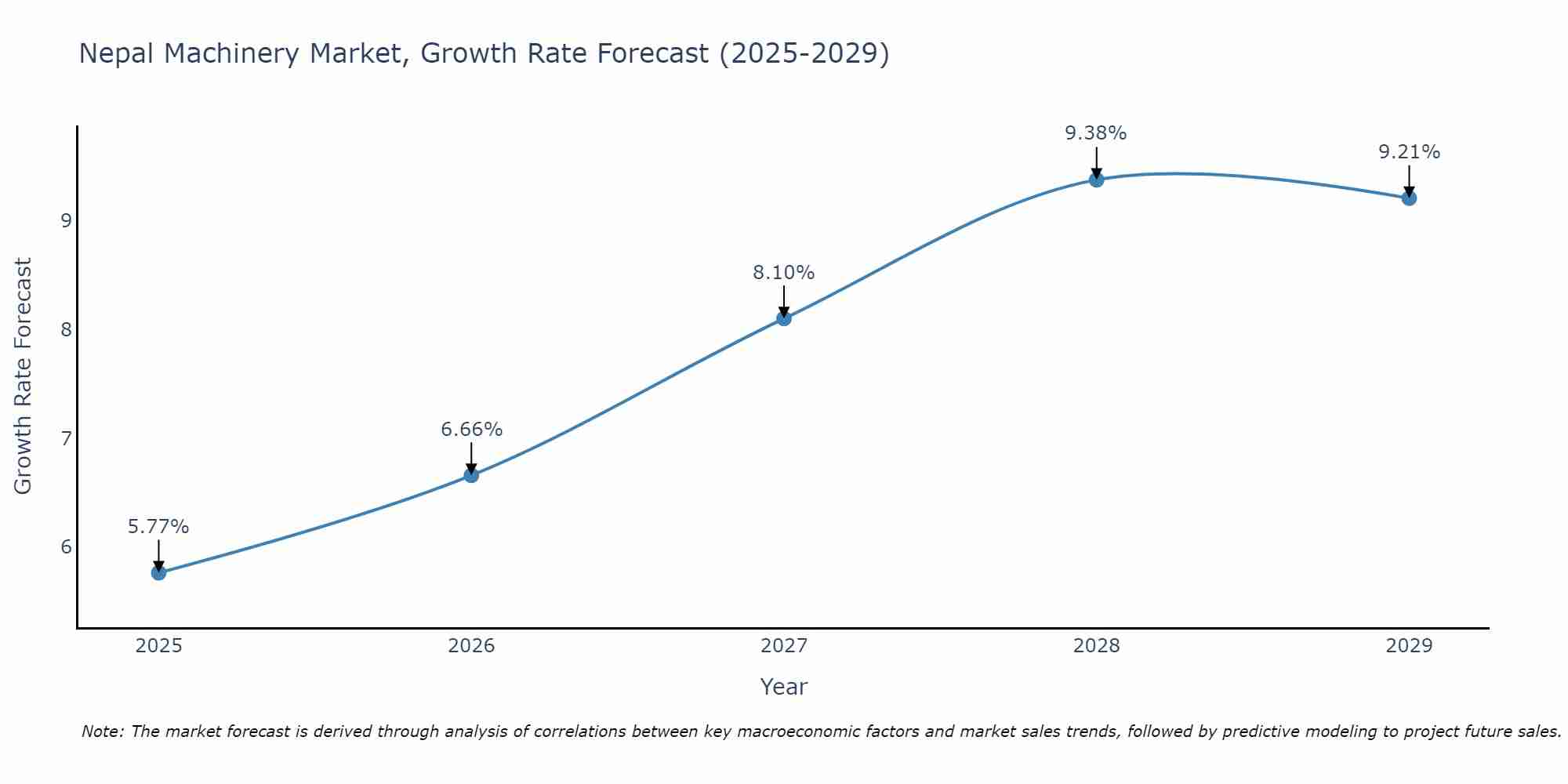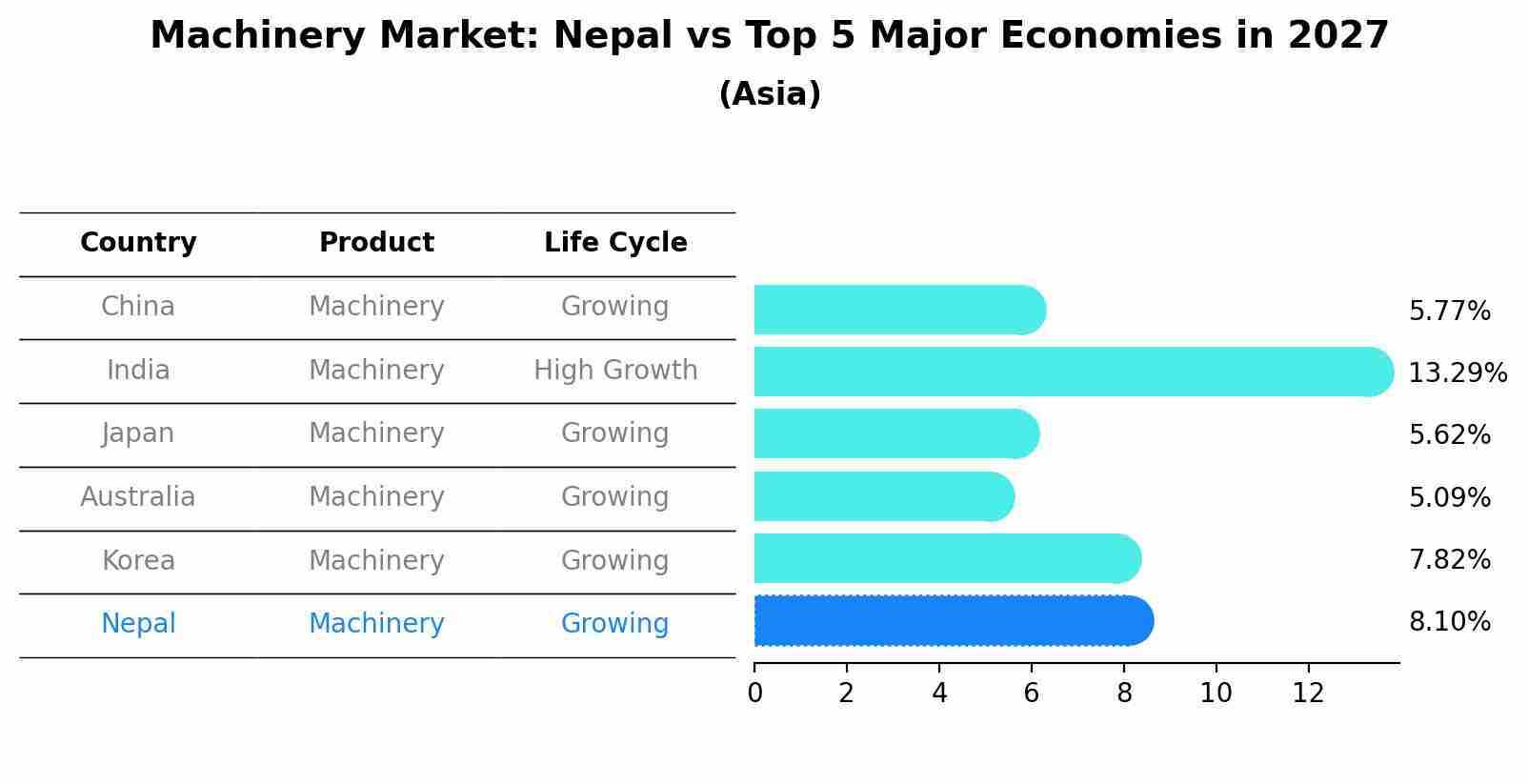Nepal Machinery Market (2025-2031) Outlook | Size, Growth, Share, Trends, Companies, Revenue, Value, Forecast, Analysis, Industry
| Product Code: ETC433172 | Publication Date: Oct 2022 | Updated Date: Jul 2025 | Product Type: Market Research Report | |
| Publisher: 6Wresearch | Author: Vasudha | No. of Pages: 75 | No. of Figures: 35 | No. of Tables: 20 |
Nepal Machinery Market Size Growth Rate
The Nepal Machinery Market is projected to witness mixed growth rate patterns during 2025 to 2029. The growth rate begins at 5.77% in 2025, climbs to a high of 9.38% in 2028, and moderates to 9.21% by 2029.

Machinery Market: Nepal vs Top 5 Major Economies in 2027 (Asia)
In the Asia region, the Machinery market in Nepal is projected to expand at a growing growth rate of 8.10% by 2027. The largest economy is China, followed by India, Japan, Australia and South Korea.

Nepal Machinery Market Synopsis
The Nepal Machinery Market is characterized by a growing demand for construction, agriculture, and industrial machinery. The construction sector, in particular, is driving the market with increasing infrastructure development projects across the country. Agriculture machinery is also in demand due to a significant portion of the population being employed in the agriculture sector. Industrial machinery sales are growing as more companies invest in upgrading their manufacturing processes. Key players in the market include both domestic and international manufacturers offering a wide range of machinery options to cater to diverse needs. Factors such as government initiatives to boost infrastructure development and rising investments in key sectors are expected to further drive the growth of the machinery market in Nepal.
Nepal Machinery Market Trends
The Nepal machinery market is experiencing a shift towards advanced technology and automation to improve efficiency and productivity. There is a growing demand for machinery that can cater to the agriculture, construction, and manufacturing sectors. With the government`s focus on infrastructure development and industrial growth, there is an increased interest in modern machinery that can meet these demands. Additionally, sustainability and environmental considerations are becoming more important, leading to a rise in the adoption of eco-friendly machinery and equipment. The market is also witnessing a trend towards digitalization and connectivity, with machinery equipped with IoT capabilities gaining popularity. Overall, the Nepal machinery market is evolving to meet the changing needs of industries and align with global technological advancements.
Nepal Machinery Market Challenges
In the Nepal Machinery Market, some challenges faced include limited access to financing for machinery purchases, high import tariffs on machinery, lack of skilled technicians for maintenance and repair, unreliable electricity supply affecting machinery operations, and a fragmented market with many small players. Additionally, political instability and bureaucracy can hinder the ease of doing business in the machinery sector. These challenges can lead to higher operating costs, reduced efficiency, and difficulties in expanding market reach for machinery suppliers in Nepal. Overcoming these obstacles would require targeted government policies to support the machinery industry, investments in infrastructure improvement, vocational training programs for technicians, and streamlined import regulations to promote growth and competitiveness in the market.
Nepal Machinery Market Investment Opportunities
The machinery market in Nepal presents various investment opportunities across sectors such as agriculture, construction, industrial manufacturing, and renewable energy. Investors can explore opportunities in supplying and servicing machinery for agriculture, given Nepal`s primarily agrarian economy. Additionally, with ongoing infrastructure development projects in the country, there is a demand for construction machinery and equipment. The industrial sector in Nepal is also growing, creating a need for machinery for manufacturing processes. Moreover, as Nepal focuses on harnessing renewable energy sources, there is a potential market for machinery related to hydropower projects. Investing in the Nepal machinery market requires understanding sector-specific needs and regulations, as well as building partnerships with local businesses for distribution and maintenance services.
Jordan Agar Market Government Policies
The Nepalese government has implemented various policies to regulate the machinery market in the country. These policies include import duties on machinery to promote local manufacturing, incentives for the purchase of environmentally friendly machinery, and regulations on the importation of used machinery to protect domestic industries. Additionally, the government has introduced schemes to provide subsidies and grants for the modernization and expansion of machinery in various sectors such as agriculture and manufacturing. Overall, these policies aim to promote sustainable growth, encourage innovation, and enhance the competitiveness of the machinery market in Nepal.
Nepal Machinery Market Future Outlook
The future outlook for the Nepal Machinery Market appears promising with steady growth anticipated in the coming years. Factors such as increasing infrastructure development projects, government initiatives to boost manufacturing and industrial sectors, and rising demand for agricultural machinery are expected to drive market expansion. Additionally, technological advancements and a growing focus on automation are likely to enhance efficiency and productivity in various industries, further stimulating demand for machinery and equipment. With a growing economy and favorable business environment, the Nepal Machinery Market is poised for continuous growth and presents opportunities for both domestic and international manufacturers and suppliers to capitalize on the evolving market dynamics.
Key Highlights of the Report:
- Nepal Machinery Market Outlook
- Market Size of Nepal Machinery Market, 2024
- Forecast of Nepal Machinery Market, 2031
- Historical Data and Forecast of Nepal Machinery Revenues & Volume for the Period 2021 - 2031
- Nepal Machinery Market Trend Evolution
- Nepal Machinery Market Drivers and Challenges
- Nepal Machinery Price Trends
- Nepal Machinery Porter's Five Forces
- Nepal Machinery Industry Life Cycle
- Historical Data and Forecast of Nepal Machinery Market Revenues & Volume By Type for the Period 2021 - 2031
- Historical Data and Forecast of Nepal Machinery Market Revenues & Volume By Agriculture, Construction, And Mining Machinery for the Period 2021 - 2031
- Historical Data and Forecast of Nepal Machinery Market Revenues & Volume By Industrial Machinery for the Period 2021 - 2031
- Historical Data and Forecast of Nepal Machinery Market Revenues & Volume By Commercial And Service Industry Machinery for the Period 2021 - 2031
- Historical Data and Forecast of Nepal Machinery Market Revenues & Volume By Ventilation for the Period 2021 - 2031
- Historical Data and Forecast of Nepal Machinery Market Revenues & Volume By Heating for the Period 2021 - 2031
- Historical Data and Forecast of Nepal Machinery Market Revenues & Volume By Air-Conditioning for the Period 2021 - 2031
- Historical Data and Forecast of Nepal Machinery Market Revenues & Volume By Commercial Refrigeration Equipment for the Period 2021 - 2031
- Historical Data and Forecast of Nepal Machinery Market Revenues & Volume By Distribution Channel for the Period 2021 - 2031
- Historical Data and Forecast of Nepal Machinery Market Revenues & Volume By Supermarkets/Hypermarkets for the Period 2021 - 2031
- Historical Data and Forecast of Nepal Machinery Market Revenues & Volume By Convenience Stores for the Period 2021 - 2031
- Historical Data and Forecast of Nepal Machinery Market Revenues & Volume By E-Commerce for the Period 2021 - 2031
- Historical Data and Forecast of Nepal Machinery Market Revenues & Volume By Others for the Period 2021 - 2031
- Historical Data and Forecast of Nepal Machinery Market Revenues & Volume By Others for the Period 2021 - 2031
- Historical Data and Forecast of Nepal Machinery Market Revenues & Volume By Nature for the Period 2021 - 2031
- Historical Data and Forecast of Nepal Machinery Market Revenues & Volume By Organic for the Period 2021 - 2031
- Historical Data and Forecast of Nepal Machinery Market Revenues & Volume By Conventional for the Period 2021 - 2031
- Nepal Machinery Import Export Trade Statistics
- Market Opportunity Assessment By Type
- Market Opportunity Assessment By Distribution Channel
- Market Opportunity Assessment By Nature
- Nepal Machinery Top Companies Market Share
- Nepal Machinery Competitive Benchmarking By Technical and Operational Parameters
- Nepal Machinery Company Profiles
- Nepal Machinery Key Strategic Recommendations
Frequently Asked Questions About the Market Study (FAQs):
- Single User License$ 1,995
- Department License$ 2,400
- Site License$ 3,120
- Global License$ 3,795
Search
Related Reports
- ASEAN Bearings Market (2025-2031) | Strategy, Consumer Insights, Analysis, Investment Trends, Opportunities, Growth, Size, Share, Industry, Revenue, Segments, Value, Segmentation, Supply, Forecast, Restraints, Outlook, Competition, Drivers, Trends, Demand, Pricing Analysis, Competitive, Strategic Insights, Companies, Challenges
- Europe Flooring Market (2025-2031) | Outlook, Share, Industry, Trends, Forecast, Companies, Revenue, Size, Analysis, Growth & Value
- Saudi Arabia Manlift Market (2025-2031) | Outlook, Size, Growth, Trends, Companies, Industry, Revenue, Value, Share, Forecast & Analysis
- Uganda Excavator, Crane, and Wheel Loaders Market (2025-2031) | Strategy, Consumer Insights, Analysis, Investment Trends, Opportunities, Growth, Size, Share, Industry, Revenue, Segments, Value, Segmentation, Supply, Forecast, Restraints, Outlook, Competition, Drivers, Trends, Demand, Pricing Analysis, Competitive, Strategic Insights, Companies, Challenges
- Rwanda Excavator, Crane, and Wheel Loaders Market (2025-2031) | Strategy, Consumer Insights, Analysis, Investment Trends, Opportunities, Growth, Size, Share, Industry, Revenue, Segments, Value, Segmentation, Supply, Forecast, Restraints, Outlook, Competition, Drivers, Trends, Demand, Pricing Analysis, Competitive, Strategic Insights, Companies, Challenges
- Kenya Excavator, Crane, and Wheel Loaders Market (2025-2031) | Strategy, Consumer Insights, Analysis, Investment Trends, Opportunities, Growth, Size, Share, Industry, Revenue, Segments, Value, Segmentation, Supply, Forecast, Restraints, Outlook, Competition, Drivers, Trends, Demand, Pricing Analysis, Competitive, Strategic Insights, Companies, Challenges
- Angola Excavator, Crane, and Wheel Loaders Market (2025-2031) | Strategy, Consumer Insights, Analysis, Investment Trends, Opportunities, Growth, Size, Share, Industry, Revenue, Segments, Value, Segmentation, Supply, Forecast, Restraints, Outlook, Competition, Drivers, Trends, Demand, Pricing Analysis, Competitive, Strategic Insights, Companies, Challenges
- Israel Intelligent Transport System Market (2025-2031) | Strategy, Consumer Insights, Analysis, Investment Trends, Opportunities, Growth, Size, Share, Industry, Revenue, Segments, Value, Segmentation, Supply, Forecast, Restraints, Outlook, Competition, Drivers, Trends, Demand, Pricing Analysis, Competitive, Strategic Insights, Companies, Challenges
- Uganda Precast and Aggregate Market (2025-2031) | Strategy, Consumer Insights, Analysis, Investment Trends, Opportunities, Growth, Size, Share, Industry, Revenue, Segments, Value, Segmentation, Supply, Forecast, Restraints, Outlook, Competition, Drivers, Trends, Demand, Pricing Analysis, Competitive, Strategic Insights, Companies, Challenges
- Australia IT Asset Disposal Market (2025-2031) | Strategy, Consumer Insights, Analysis, Investment Trends, Opportunities, Growth, Size, Share, Industry, Revenue, Segments, Value, Segmentation, Supply, Forecast, Restraints, Outlook, Competition, Drivers, Trends, Demand, Pricing Analysis, Competitive, Strategic Insights, Companies, Challenges
Industry Events and Analyst Meet
Our Clients
Whitepaper
- Middle East & Africa Commercial Security Market Click here to view more.
- Middle East & Africa Fire Safety Systems & Equipment Market Click here to view more.
- GCC Drone Market Click here to view more.
- Middle East Lighting Fixture Market Click here to view more.
- GCC Physical & Perimeter Security Market Click here to view more.
6WResearch In News
- Doha a strategic location for EV manufacturing hub: IPA Qatar
- Demand for luxury TVs surging in the GCC, says Samsung
- Empowering Growth: The Thriving Journey of Bangladesh’s Cable Industry
- Demand for luxury TVs surging in the GCC, says Samsung
- Video call with a traditional healer? Once unthinkable, it’s now common in South Africa
- Intelligent Buildings To Smooth GCC’s Path To Net Zero













